I first published an article on the Smock last November. It’s getting cold outside and the time is now to get your hands on a Smock. This article isn’t the be-all-end-all word on Smocks, but it’s a good start.
Finally, the smock is beginning to gain some traction here in the US. We’ve written about them in the past, mentioning smocks from Drop Zone, the now defunct EOTAC, SOD Gear, Level Peaks, SORD, Vertx Vertx smock and the FirstSpear Squadron Smock. But, we’ve never really talked about them and explained what they are all about.
Even though we are slow to adopt, they are literally a concept unlike anything we have in the US. I’ve heard them compared to the M65 field jacket but that idea is simply uniformed. A smock isn’t just a coat.
Rather, the smock is much more than a simple jacket. In addition to use as clothing, the smock is also intended to carry much, if not all of the wearer’s fighting load. In fact, that was the point. They were originally envisioned to carry several days of combat equipment including rations, ammunition, and radios.
Primarily, the smock is a European concept and in particular, used by Commonwealth nations. I got my first SAS smock in 1989 in a trade for a poncho liner during an exercise in Belgium. Its use as an issue garment was traditionally restricted to Special Forces yet several nations have adopted it for general issue in one form or another. One example of a much watered down smock on general issue is the Canadian Army’s combat jacket. When this design was initially adopted in the 1960s it was envisioned that the Soldier would carry his ammunition and other fighting load components in the jackets pockets. What’s more, the British military now issues a Smock as a general purpose item.
There is very limited use of Smocks by US forces. During the early 1990s, an experimental clothing system called Battle Dress System (BDS) was developed by the US Army Special Operations Command. It was a layered clothing system that eventually became the Lightweight Environmental Protection sub-system of SPEAR. The outermost layer called the SOF BDU, was a solid grey combat jacket and over trouser. With its solid grey color the item was rejected due to institutional prejudice. When LEP was adopted, it was without the SOF BDU layer.
Issue items like the SAS Smock are pretty good, but commercial interests have taken them to a whole new level. Britain’s Special Air Sea Services has been manufacturing specialized variants of the smock since the 1980s. Other companies like Canada’s Drop Zone picked up the torch in the 90s and now, commercial items are more prevalent than the issue garment.
But, for me, the most ambitious smock project of late has been the FirstSpear Squadron Smock. I will be blunt. I love it. But, with it’s gridded fleece lined yoke, it’s a cold weather garment.
Smocks have made a lot of sense in Northern Europe where the cold wet climate requires layering. You see, as smocks are coat-like garments they are generally worn layered over shirts. In many climates the US military finds itself in, this would be too warm as a daily wear item. Rather, the US Army’s Extreme Cold Weather Clothing System in all three of its incarnations has offered various technical shells. It seems as if the US skipped the smock altogether, at least for a time. But, with the advent of the most modern smocks, new fabrics have been introduced into the design essentially making them softshells. Conversely, Australian Mission Pac has developed a MultiCam ripstop 100% Cotton Smock for use in warm climates.
Crye Precision debuted a warm weather Recce smock during SHOT Show 2012. Thus far, it has not been released for sale.
Other interesting concepts have been developed such as the Arktis SF Sleeveless Smock which looks like a hybrid between a smock and a 5.11 shooting vest.
Oftentimes, those with no experience with smocks will criticize the design. They don’t understand that use of a fully featured smock allows the reconfiguration of the load. For example, armor can be worn under the smock. Perhaps a chest rig may be required and perhaps not, but much of the items carried on the armor or in a pack can be carried in pockets, readily available.
With even more products hitting the market soon, smocks look to be making an indelible mark on the US market and as they become more and more prevalent, we will begin to see more widespread use, including on the battlefield. Think of the smock as yet another tool in the toolbox and use accordingly. Remember, it’s a tool, not the tool, and you’ll be ok.
-Eric Graves
The Editor
SSD
What’s your favorite Smock?
Tags: Battle Dress System, Crye Precision, Drop Zone, EOTAC, FirstSpear, Level Peaks, SOD Gear, SORD, Special Air Sea Services, VertX


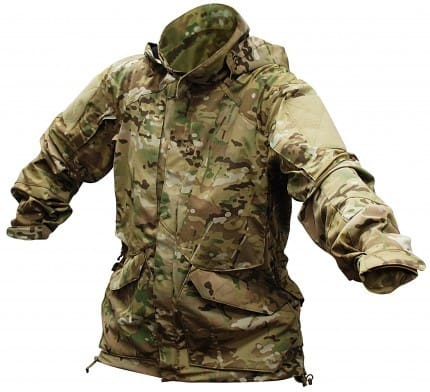
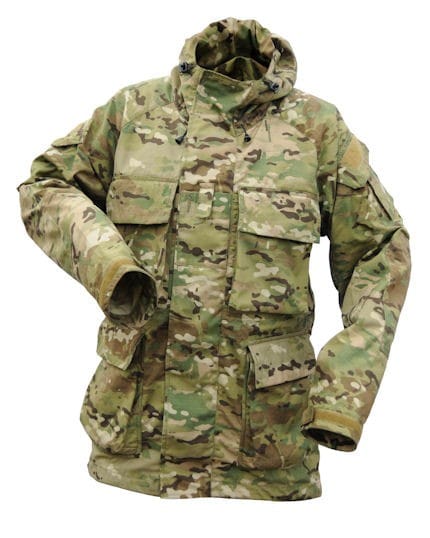
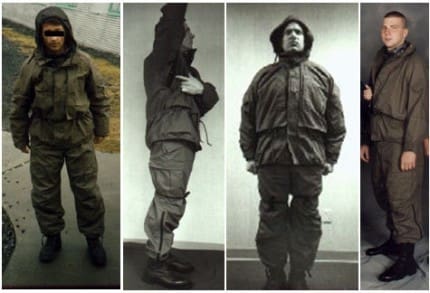
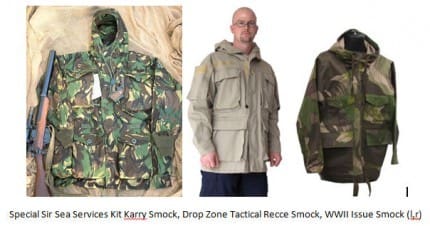
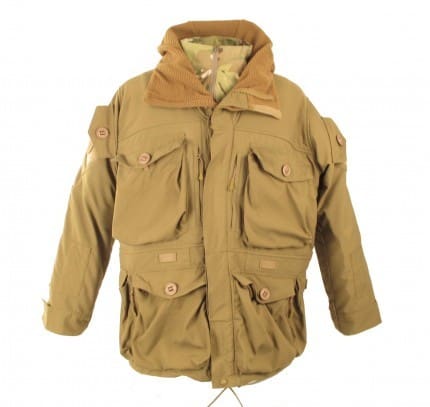
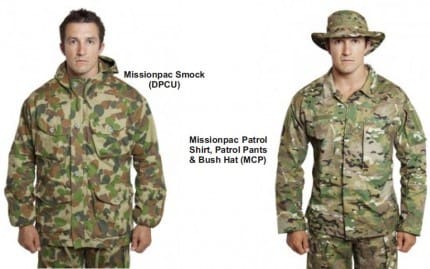
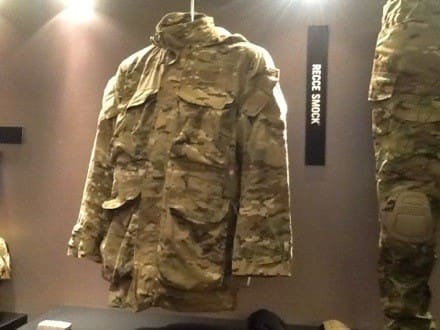
SOD Operator Field Parka in HCS.
DPM gore-tex smock issued to the UK Pathfinders. Zips to the gore-tex trousers to form a one-piece gore-tex overall.
Ah, who am I kidding. I love the current French FELIN combat smock. If it was only made from softshell material.
Please also take a look at german smocks like Sabre, Leo Köhler, German First Line & others.
Smocks are widely (in some units to the extent of everyone using one/having several for summer/winter, different applications) used in the german military.
There are pictures of german soldiers in AFG using smocks over their body armor, carrying ammunition, water & stuff in all those pockets.
I really liked the look of the FirstSpear smock but in the end I chose to support my local businesses and purchased a Drop Zone smock. It’s a great piece of gear, I can easily wear it all of the time and it has plenty of pockets for all my needs. Well designed, well made, absolutely worth every dollar I paid for it. In colder weathers, I put a fleece jacket underneath the smock and keep a light rain poncho in the pocket to keep me dry in absolutely pouring rain. Great piece of gear.
For me it’s the Sord MTC smock! Similar to the Arktis Kommando jacket with its waist pocket layout;however, the side armour access zip and arm pockets are a great addition not to mention the overall cut!
Definitely a must have as an outer layer and comes with me on every task!
For years, Arktis was THE maker of smocks for a lot of Europeans. But I get the impression they’re sticking with more or less traditional designs of smocks & fabrics. Pity.
I like how Claw gear uses MOLLE on the hips of their Pathfinder smock to enhance customisation (I’d put 2 HSGI Taco pouches there).
NZ Army moved back to smocks in about 96 (after a brief stint with swandries… a kiwi iconic jacket)… with the new uniform coming into service later this year we have re-developed the smock into a “combat jacket” as part of our normal issue.
It looks good and you should check it out.
.. and the British Windproof Combat Smock in MTP. This and the SOD Gear Parka – no need for any other whether in the range, woods or within city limits.
1. Is there a way to get the smock to transfer some of the weight on the waist? Or is all the weight carried up on the shoulders? I can see that most smocks have waist draw strings, but does that do anything more than just keep the load from swinging and bouncing?
2. Does anyone make a smock that closes/buttons/zips to the side? My brief search only found ones that close in the center. Closing in the middle is traditional and convenient, but it also takes away the most accessible area on the torso. You could fit a third pocket one each row in the center if it didn’t close there. And you could easily reach the center pockets with either hand even with your gut, body armor, and loaded pockets making you look like the Michelin Man.
The drawstrings have been used to reduce the bulk or puffiness of the jacket. This in turn will reduce heat loss by restricting the air movement. Usually there was a bottom string as well. I think there is a bit of an old school dress and deportment issue as well.
SOD gear from Italy has side zips but buttons on the front. As for buttons, think they all hace front and center buttons.
I got a Platatac Smock during this last trip to A-Stan in Multicam. Awesome piece of kit, from some great guys, and from a country that has always come to fight with us!
I properly love the level peaks smock… heaps of functionality and not overly complicated like some of the more recent arrivals. The true new SAS smock!!!
T he UK issue PCS smock is a close match to level peaks… however, quality is not so much!!! and they tend to fall to bits! Though it has fleece handwarmer pockets pit vents etc
Both these come from the UK Tantalus system origins which was by a mile the most durable smock i’ve had.
I love the features on the SASS force 8 smock, but found i wore through the ripstop quite quickly.
In summary Level peaks tech smock + softshell = 1 happy boy in the afghan winter!!!!!!
I finally got a smock after years of looking. Decided on an Arktis NYCO smock in OD. This is a great jacket for wearing around town and in the woods. Glad I finally got one.
Question: If the smock was intended as a way to carry combat equipment wouldn’t the Swiss 80’s era uniform jacket (I am not quite sure of the proper name) be one of the best designs for this purpose? Updated with modern fabric/hardware would it be viable design?
As for use by the US military, the concept is good, but why do I fear that someone may think it isn’t “Professional” -“We can’t have all that stuff in our pockets, it would LOOK bad”
I have a SASS (Special Air Sea Services) modified Kit Karry smock. I asked them to put in covered buttons, and did away with the camo attachment points (also got velcro sleeve cuffs versus the knitted ones). They also put in d-rings inside the cargo pockets (dummy-cords) and a compass pocket inside the left chest cargo pocket. I love it – it can carry a lot of stuff, and it provides a nice base to layer underneath.
Interesting article again.
Is it possible you can shed more light on the U.S. Army designed BDS smock and program? Information seems to be hard to dig up on the design of these garment on the web.
Thanks.
I’m a smock Junkie, I have 4 British DPM smocks, standard issue soldier 95, 1980s issue moleskin, and a modern SAS smock. I’ve got a Dropzone smock, a Modern German army smock in Flectarn, My most recent smock fix was provided by CLAW Gear, I ran it recently and carried my full loadout for a 24 hour operation, all ammo, all food , all radios, all navigation devices neatly tucked away in the pockets. CLAW even pits 2 MOLLE panels on the hips of their smocks for user configurable specialized loads. I put my holster on one side and a compactable dump pouch and 2 pistol mag pouches on the other.
What I like most about running a smock is the slick and limber profile, no straps or pouches to get hung up while on the move.
If you need armour, you can run a stripped down plate carrier underneath.. some of the now available “skeleton” carriers are ideal.
If you don’t have a smock, get one.. currently there are loads of Brit Soldier 95 DPM smocks available as the UK transitions to MTP and the old stock goes to surplus.
I bought a repro Brit smock last year in CE Woodland. One of the reasons was that it had all the pockets, which seems to get glossed over in describing what this garment does.
It’s really not enough to say you can carry all the gear that would fit into the cargo pockets of the LBV. It has MORE pockets than that, externally and internally, with no straps, loose paracord adjusters, or rigid belt to hang up as much on dense brush or urban obstacles. And it also accepts camo in whatever form you can improvise attached to the loops sewed in generous quantity on the back.
I’ve worn the smock in freezing rain hiking into town, it resisted the wind and iced over. The cotton material could use some rain repellant, but only got moderately damp, and actually dried out on the return trip. I wore a light fleece jacket for insulation, and was comfortable – except for my nose and cheeks. I’ve done this before, and it matched the performance of a German snorkel parka twice the weight.
Buttons are another difference – these aren’t the typical four hole stitched-on items, they are large, slotted, and attached with fabric loops. The button holes are precisely undersized to make chance unfastening nearly impossible, and won’t fray out leaving one dangling by a thread needing repair.
Exposed pockets are another finesse point – they are tall, and fold over when buttoned, to secure the contents. Typical pockets have a flap and a gap that allow things like pens or loose items to slip out. The pockets also have internal rings and slots to hold other items securely.
The rear apron is rubberized to resist wet. The length covers most of the thigh, not stopping short at the crotch, and lower draw strings can be tightened to eliminate flopping. Pit vents exhaust the upper, and some kind of hood is always included. I like the older hooded versions than my hidden type, but it’s been my experience that when you need a hood, it’s usually after you let it get too wet and the interior is soaked. The Cobra type is less prone to it, and there are others which improve on that even more. The hidden hood when deployed buttons down outside to stay.
The version I purchased is constructed as an upper vest with arms, sewn to a lower apron with pockets.When viewed that way, the construction has more options, and advantages in the technique can be exploited. But you have to shed traditional looks – said looks dating back centuries in formal uniform fashion, which is no loss as I now see it.
You can do worse than a smock, it’s easy. Just try to stuff all the gear you have to carry on the LBV in the pockets of the M65 or ECWCS. Even with the little I take deer hunting, a pack is required. With a smock, the only bit I need to rig up is a thermos. There’s a pocket for everything else.
I think the concept of smocks has mushroomed. The old SAS smock did not have slotted buttons and D rings for example, but it did have a hood and better quality material (Ventile) compared with our Combat Jackets (CJs). Never having been in the SAS I am not sure it was used to carry days worth of stuff: they had their own version of 58 pattern webbing and a later 72 pattern for that. Also note none of the the pockets are magazine size – unlike the Covert Operations Vest which SASS made in the 1980’s. This was like a zip-up waistcoat with pockets everywhere, including mag ones on the chest and a massive one on the back. It was nothing like as rugged though as the old Swiss smock someone mentioned above.
In terms of smocks the SASS Kit Karry smock took the CJ to a whole new level, with hood, many more pockets, slotted buttons, plastic D ring, knitted cuffs etc – and the possibility for further customisation if you wanted it. They could also do stuff in a variety of camo patterns.
There were other issue smocks besides the SAS – Para with beaver tail fastening and poppers on the pockets. Can’t remember the others – may have been sniper and arctic warfare.
Sadly the SASS website seems to be under reconstruction, though they still list odd stuff on Ebay. (No relation to them except as a purchaser of the above kit & more.)